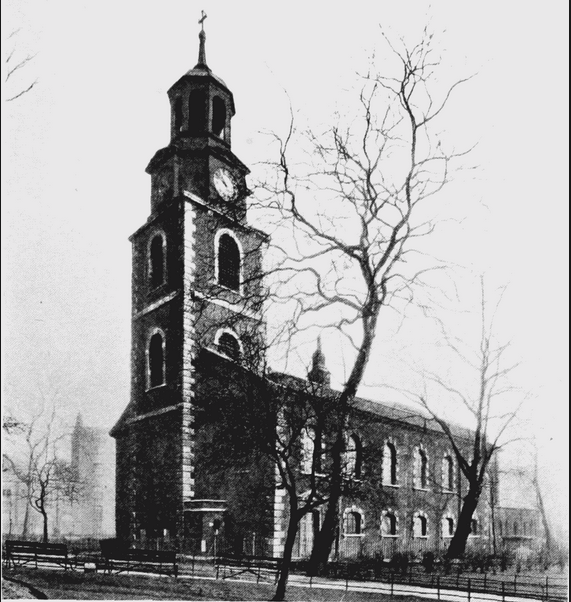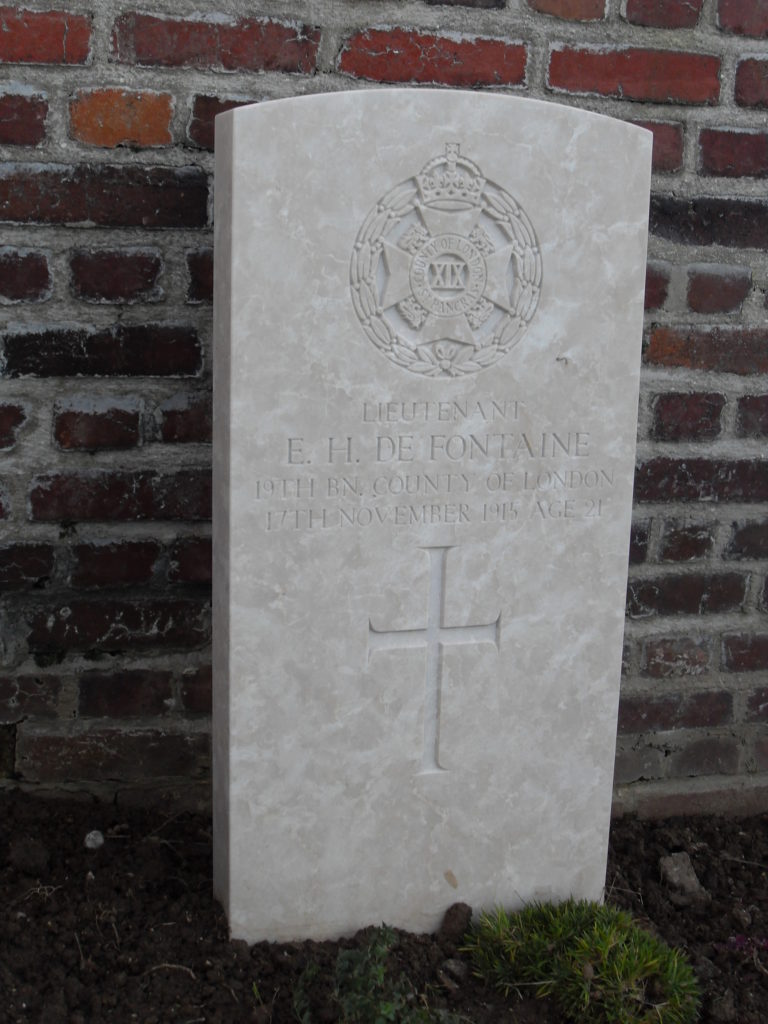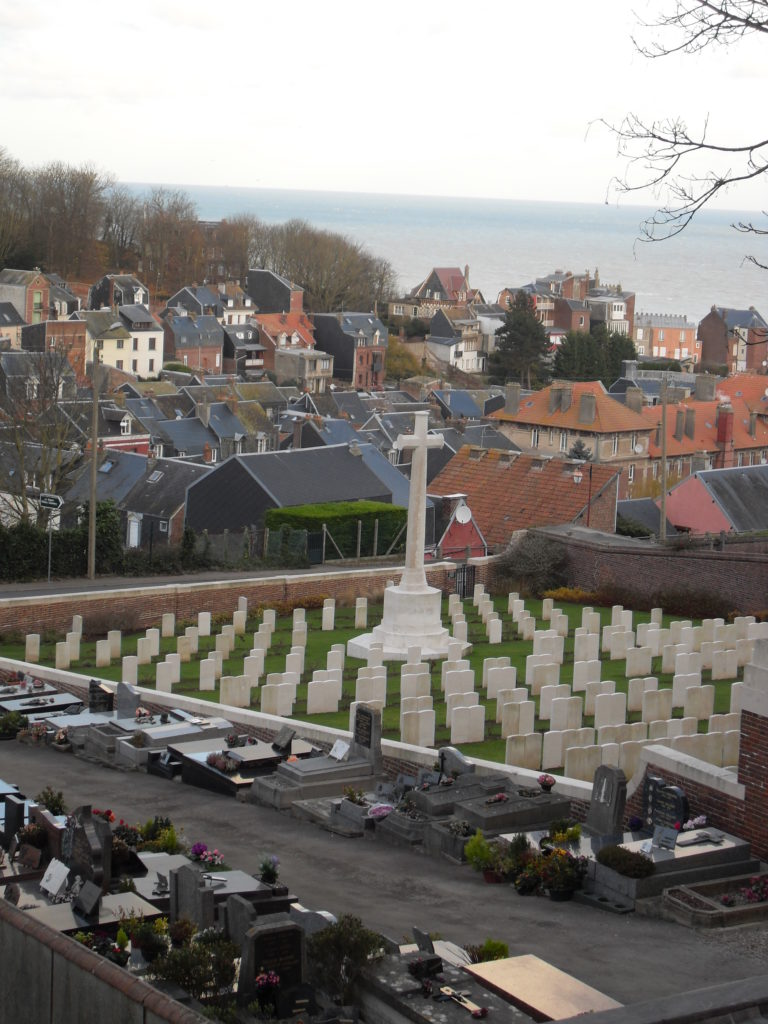Fact file:
Matriculated: 1912
Born: 26 February 1894
Died: 17 November 1915
Regiment: London Regiment
Grave/Memorial: Le Tréport Military Cemetery: 2.0.25
Family background
b. 26 February 1894 at Christ Church Rectory, Southwark, London SE1, as the youngest son of the Revd Alfred Hutchings de Fontaine, MA (Oxon) (1844–1920) and Sarah de Fontaine (née Tilsley) (1853–1923) (m. 1873). From 1878 to 1900 the family lived at Christ Church Rectory, Blackfriars Road, London SE1, and after 1900 the family lived at the Rectory, Bletchingley, Redhill, Surrey.
Parents and antecedents
Alfred Hutchings de Fontaine studied at Worcester College, Oxford (BA 1872; MA 1876), and was ordained deacon in 1872 and priest in 1873. From 1872 to 1878 he was Curate of Holy Trinity Church, Clapham, and from 1878 to 1900 he was Rector of Christ Church, Southwark (destroyed in the Blitz in 1941). From 1900 onwards he was Rector of St Mary the Virgin, Bletchingley, Surrey, a living with a gross income of £951 p.a. and the cure of 2,023 souls, and from 1902 to 1918 he was Chaplain of Godstone Union.
De Fontaine’s mother was the daughter of a solicitor.
On 22 November 1915, i.e. after de Fontaine’s death, the diarist and Fellow of Magdalen C.C.J. Webb wrote in his Diary that he believed de Fontaine to be “descended from a courtier of Marie Antoinette’s, who, when a refugee in England, confirmed to the Ch[urch] of England & married”. There is no evidence for the first part of Webb’s statement, but de Fontaine’s paternal grandfather, Louis William de Fontaine (1807–71; m. in 1844 Louisa Hutchins [c. 1809–91]) was a watch- and clock-maker, and his paternal great-grandfather, Louis de Fontaine (b. before 1766 “in foreign parts” – date of death unknown) (m. Ann, b. before 1807, surname and life dates unknown) practised the same craft. Both generations of de Fontaines lived and work in the area that is bounded by Queen’s Square, Camden (WC1) to the east and Somers Town (NW1) to the west, behind King’s Cross and Euston – one of London’s worst slum areas and the haunt of prostitutes and petty thieves, where Magdalen would open its new Mission House in 1912 (see C.I.S. Hood).
Siblings and their families
Brother of:
(1) Mary Catherine (1874–1949);
(2) Florence Margaret (1876–1957), later Reay after her marriage (1905) to Revd Basil John Mason Reay (1872–1948); two (possibly three) sons;
(3) Dora Frances (1877–1957), later Gallop after her marriage (1921) to Revd Walter Judkins Gallop (1877–1968), who had been her father’s curate at Bletchingley from 1919 to 1921;
(4) Bertrand Louis (1879–1954 [South Africa]), who married (1906) Ethel Beatrice de Thierry-Mouillot (1883 [Gorey, Ireland]–probably died [date unknown] in the South Africa;
(5) Laurence Henry (1882–1944), who married (1912) Mabel Annie Kelly (1896–1971); one daughter.
Basil John Mason Reay was awarded a B.Sc. at the University of London in 1904, and was ordained deacon in 1908 and priest in 1910. From 1908 to 1911 he was Curate of St John the Evangelist’s Church, Hanley, near Stoke-on-Trent, Staffordshire, and of the parish church of Stoke-on-Trent from 1911 to 1919. From 1916 to 1918 he was a Temporary Chaplain to the Forces and awarded the Military Cross in 1917. From 1919 to at least 1932 he was Vicar of Hednesford, Staffordshire, a mining community with a population of 11,868 and a gross income of £485 p.a.
Walter Judkins Gallop was the son of a clergyman and educated at Marlborough School. On 21 March 1900 he was commissioned Second Lieutenant in the 2nd (Hertfordshire) Volunteer Battalion, the Bedford Regiment, and did not become a Clerk in Holy Orders until he was nearly 30, having become an Associate of King’s College, London in 1911 and done a year’s training at Bishop’s College, Cheshunt, Hertfordshire. He was ordained deacon in 1912 and priest in 1913, and he then occupied six curacies from 1912 to 1928: he was Curate of All Saints’ Church, Leeds, from 1912 to 1915, of Scarborough from 1915 to 1916, of St Michael’s Croydon from 1918 to 1919, of Bletchingley, Surrey, from 1919 to 1921, of St Ippolyts with Great Wymondley, Hertfordshire, from 1921 to 1924, and of St Saviour’s Church, Hitchin, from 1924 to 1928. In 1928 he became the Vicar of Wigginton, Hertfordshire, a parish on the edge of the Chiltern Hills with a gross income of £407 p.a. and a cure of 696 souls.
Bertrand Louis was educated at Merchant Taylor’s School from c.1892 to 1898 and then at Keble College, Oxford, probably for a Pass Degree, from 1898 to 1901 (BA 1902). In Hilary Term 1899 he rowed for Keble in the first Torpids. After leaving Oxford, he fought in the Second Boer War from 1901 to 1902, but on returning to England became a stockbroker’s clerk and was declared bankrupt in 1913. His family subsequently moved to South Africa, where, in 1914, he joined Hartigan’s Horse, a cavalry unit that was based in East London and had been raised, equipped and trained in two weeks by Lieutenant (later Lieutenant-Colonel, DSO CMG) Marcus Michael Hartigan (1878 [Ireland]–1964) for operations in German South-West Africa beginning on 17 November 1914. A member of the South African Police who had fought in the Second Boer War, Hartigan recruited many of his men from a similar background and his Regiment proved a very effective fighting force. After the war he joined the Colonial Civil Service, but made his name as a pioneer broadcaster in South Africa from 1924 to 1944, where, as an announcer, he was known as “The Man with the Golden Voice”. During World War Two, he served in the South African Forces.
Ethel Beatrice was the daughter of François Albert de Thierry Mouillot (1858–1915), a distinguished Harrogate doctor of Irish descent. Her brother Augustus de Thiery-Mouillot (1883–1916) died on 12 January 1916 of wounds received in action while serving as a Captain with the 51st Sikhs, Indian Army.
Laurence Henry became a bank clerk and lived in Eastcote, Pinner, Middlesex.
Education
De Fontaine attended Lancing College as a Branthwaite Scholar from 1905 to 1912 and was a Chorister for six of those years. In 1911–12 he was the Captain of Olds House. He was elected as an Academical Clerk at Magdalen on 27 April 1912 and matriculated there, but was exempted from Responsions as he had an Oxford & Cambridge Certificate. He took the first part of the First Public Examination in Michaelmas Term 1912 (Holy Scripture) and Trinity Term 1913 (Greek and Latin Literature) and then began to read for a Pass Degree with the intention of taking Holy Orders. But after taking Group B1 (English History) in Trinity Term 1914, he left without taking a degreee. President Warren wrote of him posthumously:
He had a beautiful tenor voice which he diligently cultivated, and also good abilities, and would have done well in the History School, for which he was reading. Thoughtful, refined, intelligent, of a singularly amiable and modest disposition, thoroughly manly and sensible, his whole nature seemed to be behind his voice, and he sang with quite unusual effect and charm, and gave promise of becoming a really fine amateur. A most useful man he would certainly have been, for he exercised a very valuable influence in the choir and in the College in his quiet way. […] A more typical or better Academical Clerk the Choir and the College never contained, and his memory will be cherished and his loss mourned, for many a year, by his generation and all who knew him.
War service
Having been in the Officers’ Training Corps at Lancing and risen to the rank of Colour-Sergeant, de Fontaine was commissioned Second Lieutenant in the 1/19th (County of London) Battalion, the London Regiment (St Pancras), on 17 September 1914 and promoted Lieutenant on 5 December 1914. The Battalion arrived in France as part of the 141st Infantry Brigade in the 47th (1/2nd London) Division on 10 March 1915 and trained at Allouagne, about six miles west of Béthune, until 6 April. On the following day it marched to Béthune and spent 9 to 14 April in the trenches. De Fontaine arrived in France with the Battalion’s first reinforcements around 20 April 1915, when the Battalion was in billets at Labeuvrière, just south-east of Allouagne. It returned to the trenches on 28/29 April, and on 2 May he wrote to President Warren:
My “Baptism of fire” took place a week ago and I am now in rest billets in reserve [at Gorre, about two miles east of Béthune]. The weather has been glorious for the last day or two and the hotter it gets the more I long for a punt moored to the walks in the shade. My playing of Te Deum Patrem [the Magdalen May Morning Hymn] on a penny whistle at 5 a.m. yesterday failed to provoke “Die Wacht am Rhein” from the Germans. They generally sing to us in the early morning, but our men don’t feel moved to reply till the evening.
The Battalion was in and out of the trenches throughout the summer, and although it suffered heavy casualties during the Battle of Festubert, when it was heavily shelled from 15 to 21 May, the summer months were, on the whole, fairly quiet. The Battalion War Diary does not exist for July and September 1915, but on 25 September, the opening day of the Battle of Loos (25 September–13 October 1915), when around 8,500 British and Indian soldiers were slaughtered by well-placed and well-concealed machine-guns, de Fontaine was terribly wounded after being hit by seven bullets. After making good initial progress, he died on 17 November 1915 of wounds received in action, aged 21, at No. 3 General Hospital, Le Tréport. On 22 November 1915, the diarist and Fellow of Magdalen C.C.J. Webb noted in his diary:
In the “Times” the sad news of De Fontaine’s death. Requiescat in pace. One had hoped, as time went on, that the chances of recovery were much increased. He was a very good fellow, an Academical Clerk of the best type – genuinely religious, genuinely musical.
De Fontaine was buried in Le Tréport Military Cemetery, Grave 2.0.25. He is commemorated in The Lancing Roll of Honour (1924, unpaginated).
Bibliography
For the books and archives referred to here in short form, refer to the Slow Dusk Bibliography and Archival Sources.
Printed sources:
[Thomas Herbert Warren], ‘Oxford’s Sacrifice’ [obituary], The Oxford Magazine, 34, no. 6 (26 November 1915), p. 94.
Bristow (1995), passim.
Archival sources:
Bowley, H.T. The Lancing Roll of Honour, 1914-1919, (1924) , Record held by West Sussex Record Office.
MCA: Ms. 876 (III), vol. 1.
OUA: UR 2/1/74.
OUA (DWM): C.C.J. Webb, Diaries, MS. Eng. misc. d. 1160.
WO95/2738.
WO374/19078.



